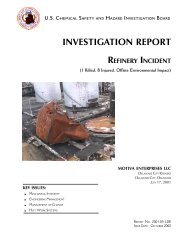CTA Report, Draft 1, ISP Review - US Chemical Safety and Hazard ...
CTA Report, Draft 1, ISP Review - US Chemical Safety and Hazard ...
CTA Report, Draft 1, ISP Review - US Chemical Safety and Hazard ...
Create successful ePaper yourself
Turn your PDF publications into a flip-book with our unique Google optimized e-Paper software.
10.2.2 Division of Building Codes Enforcement<br />
The Division of Building Codes Enforcement is separated into two functions:<br />
• Plan review: Architectural plans are reviewed prior to construction to ensure compliance<br />
with the Kentucky Building Code.<br />
• Inspection: Inspections are conducted periodically to ensure that construction is done<br />
according to approved plans. Upon final inspection, an occupancy permit is issued <strong>and</strong> the<br />
case file is transferred to the Division of Fire Prevention, Office of State Fire Marshal, for<br />
future inspections.<br />
The division has 12 field inspectors for building codes, eight plan reviewers, <strong>and</strong> three technical advisors.<br />
Inspectors use a checklist to document whether construction of the facility meets code requirements. The<br />
checklist does not address combustible dusts. No training is provided to building inspectors or plan<br />
reviewers on design requirements for combustible dusts. On November 4, 2002, the division allowed the<br />
firewalls that separated the combustible dust-h<strong>and</strong>ling production area from the finished goods storage<br />
area at <strong>CTA</strong> to be removed (Section 3.4.2).<br />
The Kentucky Building Code incorporates the International Building Code (IBC), 25 which requires<br />
buildings that store or h<strong>and</strong>le combustible dusts to comply with applicable provisions of the International<br />
Fire Code (IFC) <strong>and</strong> NFPA 654. 26 The Kentucky Building Code classifies as high hazard (Group H)<br />
facilities that h<strong>and</strong>le combustible dusts over a maximum allowable quantity. However, neither the<br />
Kentucky Building Code nor IBC specifies maximum allowable combustible dust quantities.<br />
25 The International Code Council (ICC) develops the IBC. The ICC was established in 1994 as a nonprofit<br />
organization dedicated to developing a single set of comprehensive <strong>and</strong> coordinated national model construction<br />
codes. The founders of the ICC are Building Officials <strong>and</strong> Code Administrators International, Inc.; International<br />
Conference of Building Officials; <strong>and</strong> Southern Building Code Congress International, Inc.<br />
26 The provisions of IFC apply to matters affecting or relating to new construction in buildings only where<br />
specifically referenced in the Kentucky Building Code.<br />
87









